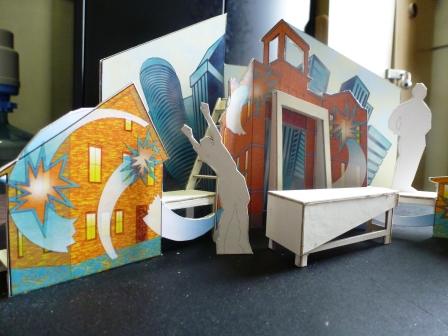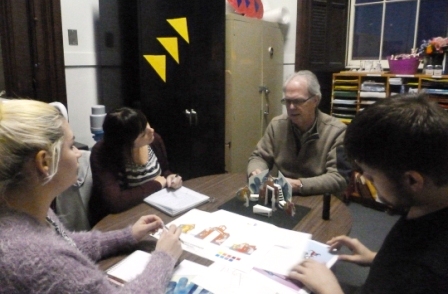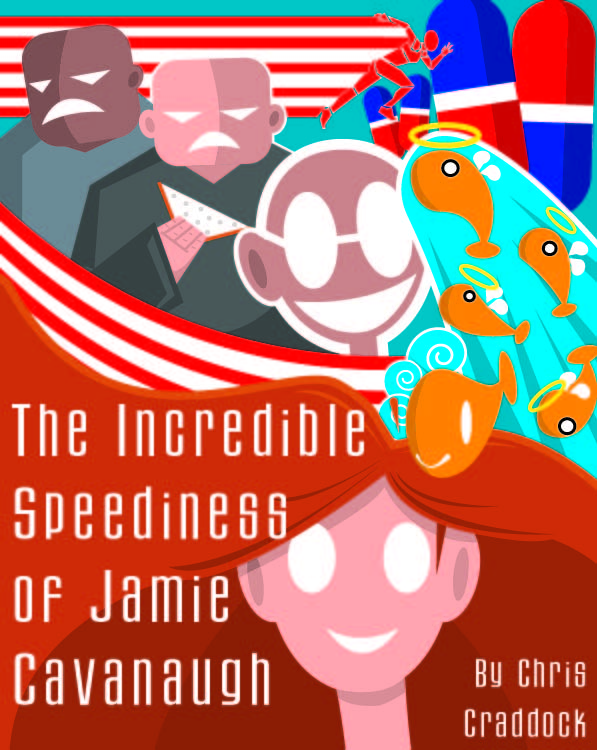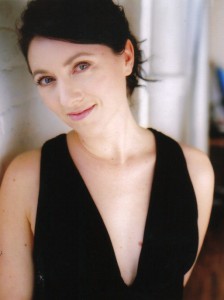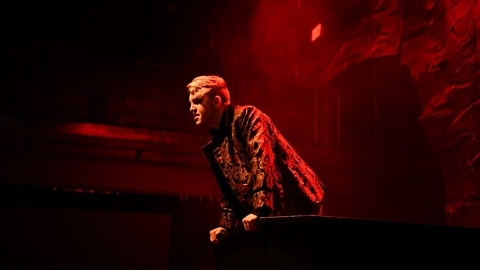For nearly two years, theatre lovers have felt entrapped in their own little purgatories. Artists have been unable to perform on stages, and audiences been...
Behind the scenes at Carousel
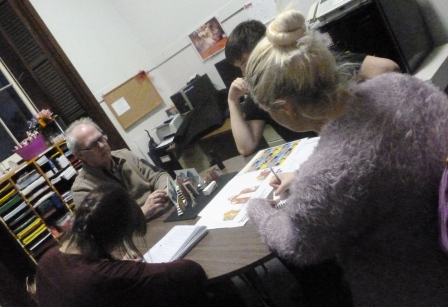
Set designer Nigel Scott with DARTcritics Natalie Allaire (left), Cole Larson, and Trella Noctor at Carousel Players’ offices in St. Catharines. Photos by Jane Gardner.
Natalie Allaire, Cole Larson, and Trella Noctor write: Picture three buildings. The buildings to the left and right are houses, and the center building is a larger structure. Platforms run on and between the buildings, and ladders on both sides of the larger structure lead up to another platform, all of which will be climbed on by the actors. The platforms are connected by bright swooshes — the kind of trail that would be left behind by a speedy superhero. Behind the buildings is a backdrop of skyscrapers jutting up into the sky, creating the silhouette a suburban environment with a busy city in the distance.
This is a description of the set of Carousel Players’ The Incredible Speediness of Jamie Cavanaugh, as described to us by designer Nigel Scott, in another exciting session of our behind-the-scenes reporting experience. In our meeting on November 18th at the Courthouse Theatre in downtown St. Catharines, Scott shared many insights about designing this set, and briefed us about how the designs will be made into reality in time for the show’s opening in January 2015.
In the month since our last session, Scott has completed his design. The setting of the play was evoked and inspired by superhero comic books and the video game SimCity. He expressed that it is essential to locate this play in a suburb just outside of a large city in order to keep up with its chaotic mood. The houses and building are not intended to represent specific geographic locations but are used as interchangeable spaces so that many locations can be shown during the production. An example of this is the large building in the center of the stage. It is intended to represent professional buildings such as the school and hospital.
Scott shows us the inspiration for the skyscraper backdrop, a photograph depicting a mysterious Batman-like city. The colour palettes that Scott utilizes for the set include warmer bright colours such as orange, yellow, and red, along with cooler and darker colours like blue, and purple. Scott added the superhero swooshes to the set to illustrate the speediness of the central character, Jamie, who has ADHD. Jamie will show her lightning speed as she moves from location to location in front of the swooshes. In the Courthouse Theatre, lights will also be used to exaggerate the comic-book nature of Jamie’s speediness, and to indicate the passage of time; lights will not be used in performances at schools, however, as that would call for a too complex of a set-up.
We found out at the initial workshop that pieces of furniture on the set would be on wheels for easy mobility; Scott told us that this idea came out of a key inspiration for the set – a pinball machine. The moving furniture is intended to evoke the chaos and speed of the pinball as it ricochets around the machine. The rolling furniture will allow for an abundance of physicality on stage and make movement freer for the actors. As Scott mentioned, the first mounting of this show had over two hundred props, which was not easy for the actors, so everything that can be done to make their jobs more streamlined is welcome!
Carousel Players insists on having the set in place from the very start of rehearsals so that the actors can fully experience it and allow for physicality, which is essential in children’s theatre, to emerge. Scott agrees that it is a very useful way of rehearsing because sometimes, when the set is not present, actors get used to blocking with set pieces that are nothing like the final product.
We asked Scott if the complex set design – with its colour scheme, its swooshes, and its backdrop of skyscrapers – might be distracting for audiences of middle school students. Scott believes it will work well because the set will draw in the audience as soon as they enter the theatre so they get excited and start to understand how superheroes and comic books are used in the play. On reflection, this reasoning does make sense because if the set can pull the audience in quickly, their focus on the stage action could indeed be heightened. Normally, keeping a student audience interested during a play is difficult, but with all of the elements being used in this production, the quickness of Jamie Cavanaugh should keep the audience’s attention!
Scott underlined how the initial workshop, which we wrote about in our first blog, contributed to the set design. He says he approaches design by taking on board the actor’s perspective, to make sure the set is usable and useful. An idea that Scott took from the preliminary design workshop was the use of the ladders as raised areas for acting. The set is designed so that there are ladders and stairs leading to various acting spaces, such as Jamie’s hideout, which will be the highest place where performing happens. Creating various levels of acting space also helps evoke the larger atmosphere of a suburban neighbourhood.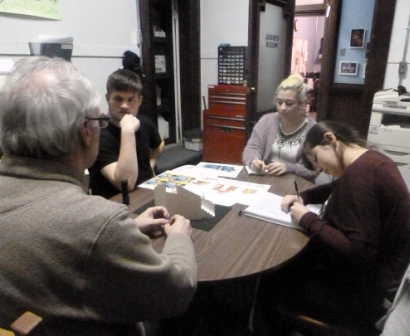
By challenging the conditions and scenarios in the play, Carousel Players will be creating more dynamic scenes than would be imagined if you followed the specific description of action in the script. Many of the scenes are written to take place sitting down, but Carousel Players will be performing a version of The Incredible Speediness of Jamie Cavanaugh that is anything but static.
The set is being built by a company in Burlington and will be ready for rehearsals in early December. It goes without saying that we cannot wait to see what the play will look like when the actors are cast and the atmosphere of the production starts to be created on Scott’s set.
Three of this year’s DARTcritics – Natalie Allaire, Cole Larson, and Trella Noctor – have gone behind the scenes of an upcoming production at St. Catharines’ acclaimed theatre for young people, Carousel Players. Here’s the group’s first report.
Carousel Players is proud to be producing the lighthearted piece of children’s theatre, The Incredible Speediness of Jamie Cavanagh, in early 2015. The production will have a short run at the Courthouse Theatre in St. Catharines, Ontario in January (including two public performances on January 31st), and then tour local schools. While it is only the beginning of the journey, Carousel hosted a workshop in late September including the director (Kerry Ann Doherty), sound designer (Michael Rinaldi), set designer (Nigel Scott), actors, and Carousel’s artistic director (Pablo Felices-Luna). The workshop involved a rough blocking session of scenes that required particular focus, in which the group determined some interesting movements and chose many sound effects. Doherty and Felices-Luna’s vision for the set includes wheels on set pieces and having different levels, to both be playful and portray different houses that the characters live in. During the workshop, they decided on some rough pieces of the set including office chairs, a table, and a door frame (all with wheels), as well as ladders and platforms with bars on them that make it possible for the actors to swing in and out of a scene.
Felices-Luna says that this part of the process is very collective and open because nothing right now is set in stone. He noted that he and Doherty are able to bounce ideas off of each other without overstepping boundaries because they have a strong working relationship that allows them to suggest changes. He also says that he is actively involved in this crucial part of the process because he has worked on previous productions on the play at Toronto’s Roseneath Theatre Company, and at Carousel. Felices-Luna is a Carousel Players veteran, having served as the company’s artistic director for nine seasons.
The play focuses on serious issues in a playful and comedic way. It revolves around a young girl named Jamie who thinks that her ADHD is the super power of speediness. Jamie goes through a series of events including dealing with bullies, fighting with her best friend, and trying to get a handle on her super power with the help of her parents. While it treats some complex matters such as psychiatric disorders, bullying, divorce, and identity, the play is written to get its points across in a way that won’t weigh heavily on children.
It was very refreshing to see such a collaborative process! Being able to watch the beginning where decisions are being made, and witness how much the director trusts the actors’ instincts, has us believing that this show will be very strong. The show looks as though it’ll be very physical with large movements within a small but elaborate set. It was an ongoing process of trial and error not only with design but also blocking.
It was truly fascinating to see the process the company took to collaboratively create the scenes. They explored and played together within given the rules and everyone had an equal say. Felices-Luna said, “Why make something that will only work for ten shows when we can make it work for forty?”
The company will move from school to school daily in its Ontario tour. Doing this is evidence of the dedication this company has to their work; they want children to engage in deep, sensitive topics that are not normally addressed in their curriculum, and are committed to high production standards.
After the actors and the director finished the workshop, we sat down with Felices-Luna to ask some questions about the creative and design processes, and Carousel Players’ mandate. This was a stimulating journalistic experience that helped us understand the journey that the show has gone through over the years, and the dedication of the company to continue telling this story.
We asked Felices-Luna about the goals of the workshop and what he and Doherty hoped the actors and crew would accomplish over the span of the day. “We have a design workshop as part of our creative process because we normally rehearse on set from the first day of rehearsal,” he explained. “It’s very important that early in design, we have an opportunity to bring in the director, the design team, and a few actors to play and explore some of the images, visual components, and the sonic components of the play in order to be able to shape our ‘design envelope’ for the play. The design envelope is how those visual and sonic elements are going to interact with the audience.”
We then asked Felices-Luna if the creative team had a preliminary design idea before conducting the workshop. “The director and the designer come into the workshop with a certain number of ideas, and we call them ‘rules’ of what we are going to explore,” he said. “For instance, going into this, we did not want to get locked into a play that worked like film or television, where you are changing locations, reconfiguring and placing a lot of energy on scene changes. We knew that we were in a world that needed to be quite theatrical and needed a very strong visual metaphor to allow us to cover the various locations.”
Who chose this play for the company’s 2015 season? Felices-Luna humbly replied, “That was me. The artistic director of the organization has the responsibility of figuring out what the programing is, what plays we will be working on, whether they are existing plays or works we have in development. That’s the decision I make with the consultation of our general manager, and then we bring that to our board of directors and say that this is the season we would like to put forward.”
What message do they want the adult audience to take away from the production as compared to younger school audiences? “We don’t really like approaching any piece of theatre from the point of view that we’re trying to communicate a simple message to an audience. We’re more interested in what it is that the audience has to offer us and what they think of the production. I personally think really good theatre asks provocative questions and provokes debate and discussion. So, say in a play like Jamie Cavanaugh, where there is a character that has ADHD and components touching on how to medicate children and how to help children who learn differently. There is no simple message attached to it; what we do is that we use the play as a springboard to have a conversation with the audience.”
We finally asked how this production compares with other shows Carousel Players has put on. “We do shows for four to eight year olds, that tend to involve a lot of participation work, but the narrative devices are different. The target for Jamie Cavanaugh is for nine to thirteen year olds as the play has more of a story. At this age, there is a great curiosity of interest in social justice, issues of right and wrong, and determining one’s moral compass. We like to put on plays for this age range with these kinds of issues being examined, like how do we deal with people who learn differently? How do we help them? What does it take to be friends with people who have very different needs from our own? That’s the kind of work we tend to do for this age range and Jamie Cavanaugh seems to fit perfectly.”
It will be very exciting to see the next rehearsal to observe what has changed and what has stayed the same. What we saw in that workshop was the work of people who truly care about portraying important and serious issues in a lighthearted way for youth to understand. Seeing the dedication from the actors in their roles, and the hard work from the directors and designers will create a show that won’t disappoint! — Natalie Allaire and Cole Larson
Related Posts
It’s been a few weeks since the final performance of Brock University Department of Dramatic Arts’ Fall Mainstage, Scenes from an Execution. Closing off their...
Here’s Holly Hebert’s final solo vlog from behind the scenes of the Fall 2020 DART Mainstage, Scenes from an Execution. She and Asenia will round off this...
It’s been a few weeks since the final performance of Brock University Department of Dramatic Arts’ Fall Mainstage, Scenes from an Execution. Closing off their...
Here’s Holly Hebert’s final solo vlog from behind the scenes of the Fall 2020 DART Mainstage, Scenes from an Execution. She and Asenia will round off this...
Leave a Reply (Cancel Reply)
Twitter Feed
Blogroll
DARTcritics.com is partially funded by the Marilyn I. Walker School of Fine and Performing Arts, in support of student learning; experiential education; student professionalization; public engagement with the teaching, learning and production activities of the Department of Dramatic Arts; new ways of thinking; and the nurturing of links with our communities.


